The Pillar and the Vastness: A Longitudinal View of the Tolkien Fanfiction Fandom by Dawn Walls-Thumma
Posted on 3 June 2021; updated on 3 June 2021
This paper was previously presented at the Popular Culture Association/American Culture Association (PCA/ACA) conference, held online on 3 June 2021.
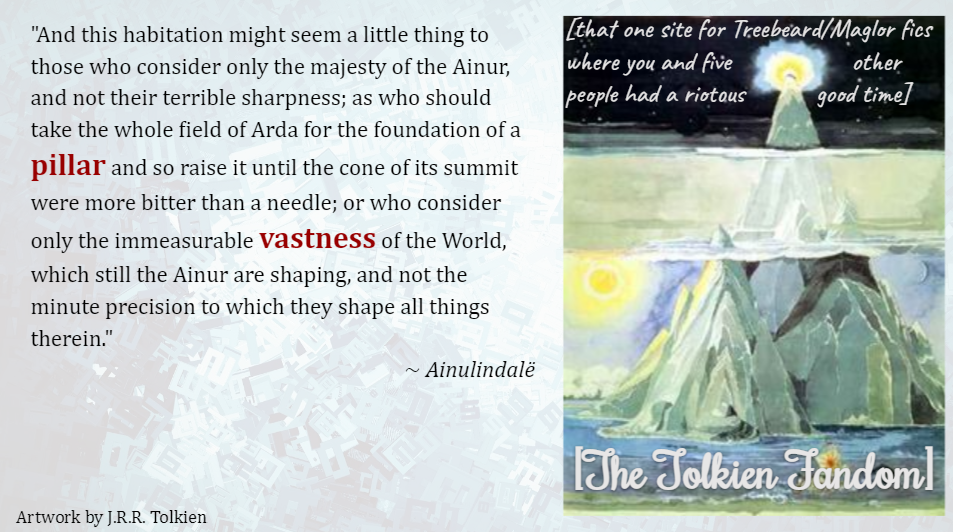
There is a line in the Ainulindalë, the creation myth in The Silmarillion, about the duality of the Ainur when they created the world, describing their majestic vastness but also their "terrible sharpness"—in other words, their ability to perceive not only the big picture but to dive into the details. As I've spent the last five years studying the Tolkien fanfiction fandom, when I think of the task, this line comes to mind. It is at once vast: One of the oldest fanfiction fandoms and one of the largest. But that "terrible sharpness," that need to drill down into the highly specific, is there as well. Just as the narrator of The Silmarillion cautions his audience about Arda, one cannot speak of a monolithic "Tolkien fanfiction fandom" and receive the whole picture. Instead, at various places and times, there are subcultures that differ profoundly from one another, and the picture of "Tolkien fanfiction fandom" is incomplete without them
Today, I am going to look more at the vastness of what I've learned of the Tolkien fanfiction fandom across the past five years. Even though I just cautioned against viewing the Tolkien fanfiction fandom as monolithic, I will often refer to trends as a whole that I see as "the Tolkien fanfiction fandom" or "Tolkienfic fandom," in the interest of brevity and simplicity. These trends are based on data from the Tolkien Fanfiction Survey, and they don't and can't represent the entirety of the Tolkien fanfiction fandom. First run in 2015, this survey captured data on attitudes, values, and practices self-reported by writers and readers of Tolkien-based fanfiction. In 2020, in collaboration with Maria Alberto, we ran the survey again. I've had my hands on the data for just about two months now, so it is still not fully analyzed and this conference is the first time I've presented anything from it, but I hope to provide a snapshot of what the fandom looks like at this moment in its history, as well as how it has changed (or not) in the last five years and some preliminary conclusions that, if my first presentation of the 2015 data is anything to go by, I will spend the next five years merrily debunking.
Demographics
To begin with, who writes and reads Tolkien-based fanfiction? For the 2020 iteration of the survey, Maria and I decided to expand out the demographic items considerably. Therefore, for many of them, there is no 2015 data with which to compare. In the interest of time, I will show much more data in the presentation than I have the opportunity to discuss.
In both 2015 and 2020, we asked participants about their gender identity. Fanfiction is almost universally discussed as a "woman's genre," and the received wisdom is that 90% of fanfiction is written by women, a number that has been confirmed by several surveys. The earliest citation of this data point I have found was in a 1980 Star Trek fanzine; it was confirmed in 2013 by CentrumLumina's AO3 Census and again in 2015 with my own survey.
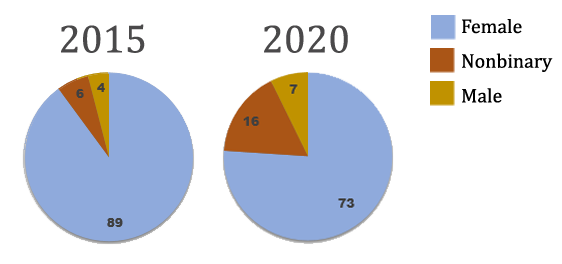
As you can see, in 2020, that data has begun to change. Just 73% of participants identified as women, and the number of participants identifying as nonbinary and as men both grew. Perhaps these data reflect growing openness about nonbinary identities. Perhaps, as the Tolkien fandom becomes more open to discussing issues of inclusivity, more diverse fans feel welcome to participate. Perhaps it is a mix of both and other factors; regardless, the simplified (and always problematic) notion of "fanfiction as women's writing" is no longer so simple.
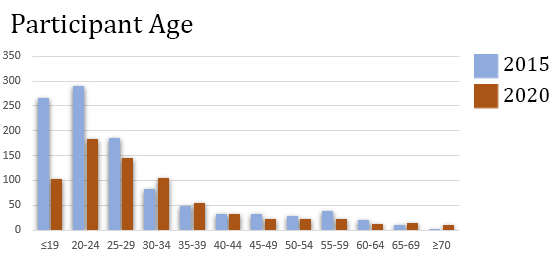
We also collected data on participant age in 2015 and 2020. You can see that the fandom has gotten older since 2015. While the younger demographics remain more heavily represented, the extreme interest in the fandom from older teens and young twentysomethings has flattened quite a bit. Relatively speaking, there is more participation now from older fans as well compared to 2015. Over 40% of the fandom is over 30 in 2020, compared to just under a third in 2015. I suspect that the high representation among young fans in 2015 was a product of the fact that the 2015 survey was released as the Hobbit film trilogy wrapped up, and the 2015 results show a high level of interest in the fandom among young people due to the films.
We introduced three new demographic data sets in the 2020 survey: race/ethnicity, education, and religion. Race and ethnicity was presented as a free-response field, in recognition of the international nature of the Tolkien fanfiction community. As Maria and I discussed adding this item, including with fans who didn't live in Western nations, we came to the realization that terminology used to discuss race, primarily in the U.S., wasn't always accurate or relevant to fans from outside the U.S. Furthermore, Western-centric racial and ethnic distinctions didn't always encompass identities from non-Western nations that were part of those fans' identities and that informed their experience of fandom. We settled on allowing participants to describe their identity however they chose. As a result, percentages should not be interpreted as either/or. For example, that 71% of fans identified as White does not mean that the other 29% identified as Black, Indigenous, and Persons of Color, simply that 71% of fans included "White" somewhere in their response without combining it with another racial identity.
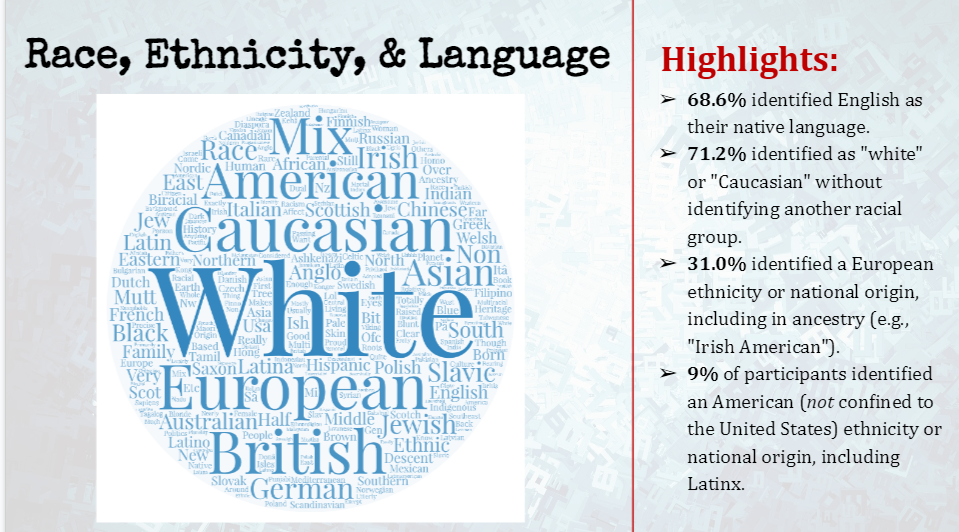
The word cloud shows the diversity of descriptions participants used for this item. It also shows that, predominantly, the fandom identifies as White and Western. As the Tolkien fandom grapples with racism both within the legendarium and the fandom, I feel like these data speak to the imperative to address both, as nonwhite fans are severely underrepresented in the fandom, and it is worth asking why and what we can do to correct that.
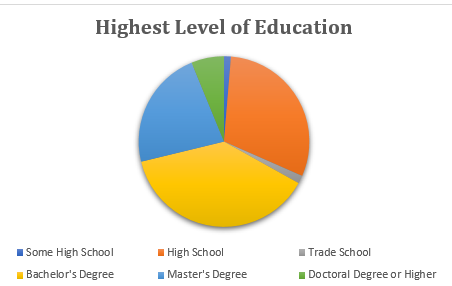
Data for education likely reflect that younger demographics are heavily represented, including young adults who have not completed their university degree. Parsing this data alongside the age data will provide a clearer picture of what these numbers mean. The data do show that the trades are not highly represented in fandom, that when participants pursued education beyond high school, it was almost unequivocally at a college or university.
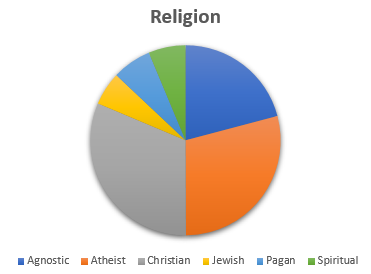
In terms of religion, almost exactly half of participants identify as atheists and agnostics. Almost a third of participants are Christians. Most of the major world religions are represented among the data; however, as with the data on race and ethnicity, most participants identify as part of these three groups.
These data give a picture of, if not the entire Tolkien fanfiction fandom, the participants who responded to the survey. It paints a picture of a fandom that, while becoming more diverse at least in terms of age and gender, still has low representation among specific demographics, namely BIPOC and working-class fans.
Sources and Film Influences
In understanding how fans construct stories about Tolkien's legendarium, sources and the canon derived from those sources stand in the foreground. To say that Tolkien's canon is complicated is an understatement: There are two books published in his lifetime undergirded by well over a dozen texts assembled posthumously, containing a mixture of coherent narratives compiled and edited by Christopher Tolkien—The Silmarillion is the best example here—and drafts, notes, and snippets, also compiled by Christopher, and in various stages of completion and sometimes highly contradictory. Added to the complexity of the written texts, there are multiple media adaptations as well, most notably a pair of blockbuster film trilogies. How fanfiction writers navigate and utilize this myriad of texts is a central question in studying Tolkien fanfiction.
The data on the slide show the percentage of authors who used various texts as part of their fanfiction.
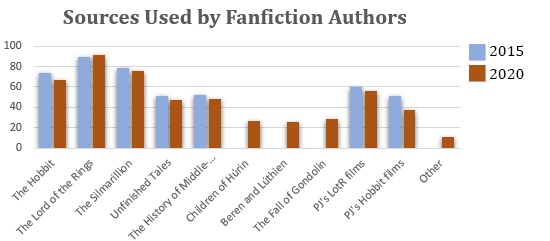
I want to begin with two big conclusions about the data so far—with a friendly reminder that the data is still very new, and I expect that as my understanding of it expands and grows more complicated in the months and years to come, some of these conclusions may change. First, as I did my preliminary analysis of the data, what struck me the most was how little if had changed between 2015 and 2020. The source data is an example of this. With the exception of the Hobbit films being used by 14% fewer fans in 2020 than in 2015, authors' use of specific sources in their fanfiction remains remarkably unchanged across the years. In yesterday's reader reception roundtable, I presented two data sets about critical and inferential motives for writing and reading fanfiction that I also described as remarkably unchanged, and this is true of other data sets throughout the survey as well.
This hearkens back to my opening quote from the Ainulindalë. In these "remarkably unchanged" sets of data, I wonder if we aren't getting a suggestion of the vastness: of a long-running and stable fandom culture. After all, the Tolkien fandom has been around for more than six decades, and fanfiction writing has occurred in some form or another across most of those six decades. Furthermore, fans tend to stick around long enough to carry an existing fandom culture forward to subsequent generations. A fandom friend of mine once described what she termed "flash fire fandoms": those that experience a brief period of intense activity before abruptly fading. Tolkien fanfiction is not a flash fire fandom to many. In 2020, authors had been writing for a median of five years, up from four years in 2015. Furthermore, about a third of authors had been writing for ten years or more, long enough to remember the fandom before the Hobbit trilogy and carry attributes of that culture forward.
Next, returning to the specific source data on the screen, there is the matter of the books, the films, and which are being used to inspire fanfiction. In the 2015 survey, I fully expected to find a significant contingent of participants writing fanfiction based on only the films. When the survey opened, the final Hobbit film was still in theaters, and fannish excitement around the films remained high. What I found was some of the most surprising data to come out of the 2015 results: Only a half-percent of participants used only the films to write their fanfiction.
These numbers hold true moving forward into 2020, where still less than a percent of participants responded that they used only the films as a source and none used only the Hobbit films. This leads me to uphold my 2015 conclusion that the Tolkien fanfiction fandom is primarily a book or literary fandom. While the films have an indisputable influence—I'll discuss more on what that influence looks like in a second—even among fans brought to the fandom by the films, once they reach the point where they want to write fanfiction, almost universally turn to one or more of the books.
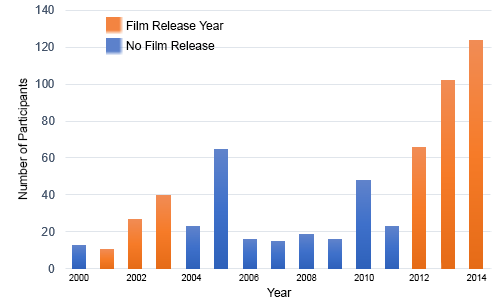
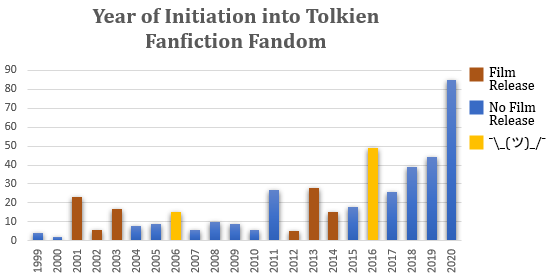
So how do the films influence the fandom? On the screen are data showing the number of survey participants who entered the fandom in any given year, for both 2015 and 2020. I've highlighted the years where there was a film release. Both data sets show a jump in fandom participation around film releases. Even twenty years later, the impact of the Lord of the Rings films can be seen on people writing in the fandom today. I interpret these data as showing that the films tend to bring new fans into the fanfiction community, which is not itself surprising. Again, as noted above, what's surprising is that nearly all of those newcomers, when they begin writing fanfiction, open one or more of the books.
I've also highlighted two years—2006 and 2016—on the 2020 data set and labeled them with a shrug because I'm not sure what is going on here. About two years after the final film release, for both trilogies, there is a jump in fanfiction writing. This can be seen as well in 2006 in the 2015 data. What's happening here?
What I suspect is going on is what I noted earlier: The fanfiction fandom is a book fandom. People may be Tolkien fans after seeing just the films, but they become Tolkien fanfiction writers after reading the books. This jump in interest in fanfiction a year or two after seeing the final film could represent the time the author spent reading the books and beginning to grasp the book canon in all its complexity.
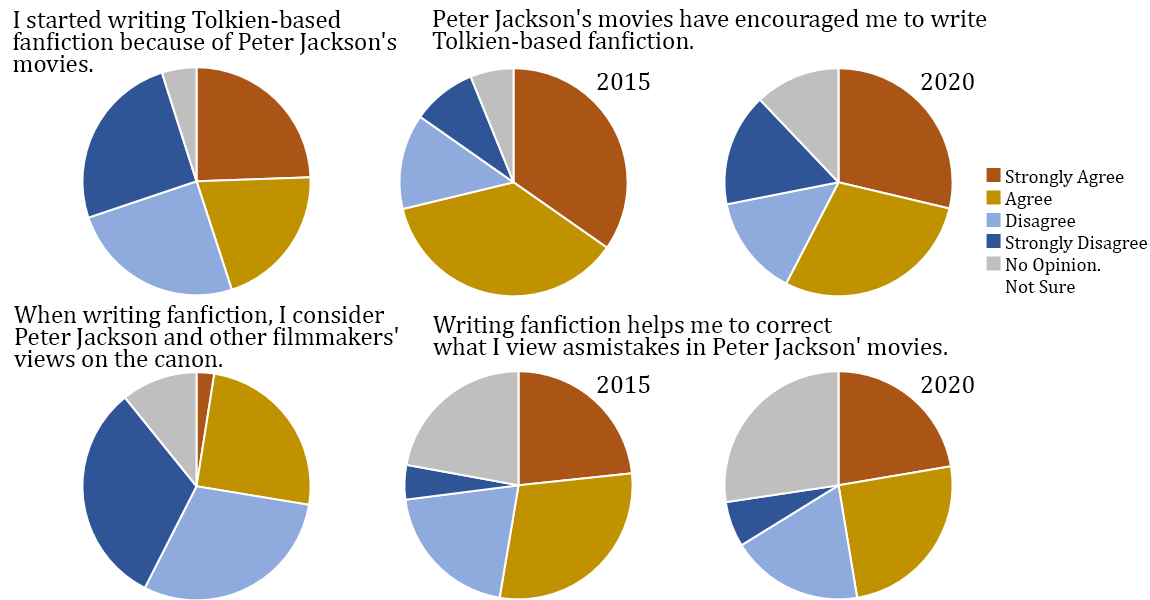
Other data from the survey support the idea of the films serving as a gateway to the fandom. 45% of participants in 2020 agreed that they started writing Tolkien-based fanfiction because of Jackson's films. A majority also agreed, in 2015 and 2020, that the films encouraged them to write fanfiction. This influence was stronger in 2015, again showing the impact of the films at a time when the films were still in or just out of theaters.
Beyond serving as an impetus to write fanfiction, the influence of Jackson's films diminishes somewhat from there. Just over a quarter of fan-authors take Jackson's views on the canon into account when writing fanfiction—and here, it's important to note, as other scholars have done, most notably Amy Sturgis, that "views on canon" doesn’t necessarily require acceptance of some of Jackson's more controversial changes. In a 2005 study of how fans used the Lord of the Rings films in their fanfiction, Sturgis found that authors often used visual details of characters and settings.
Archives and Sites
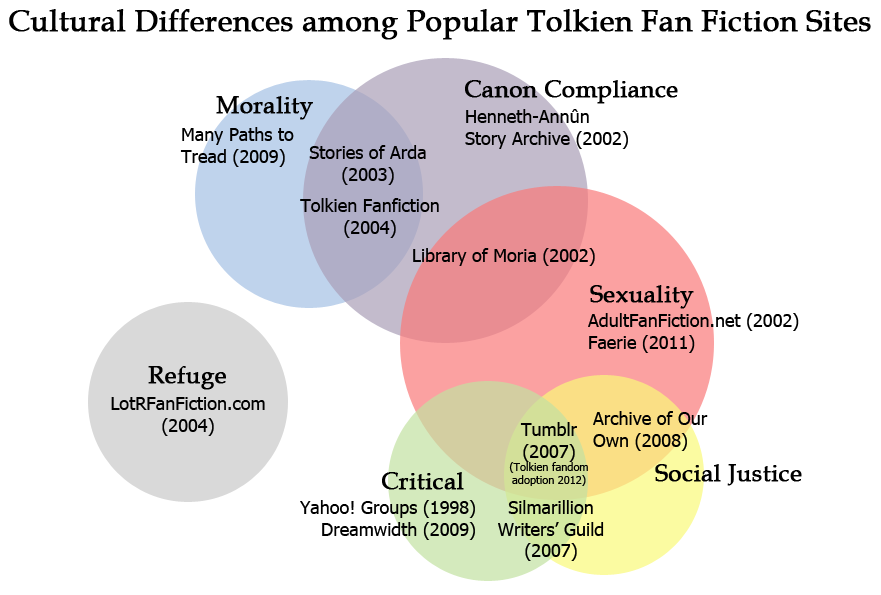
Finally, I want to talk briefly about where all this fanfiction writing is happening. One of my main areas of focus in 2015 was on the sites and archives where writers were posting their fanfiction. Looking at how authors from different sites responded differently to the survey items, I was able to pinpoint distinct fandom cultures between the sites. The graphic on the screen is one of my favorites to come out of the 2015 survey, showing how the most popular fanfiction sites differed in the values and motives that their authors identified. What is notable to me is the lack of overlap: No more than two sites occupy the same cultural niche, producing a diverse array of options for authors and readers to share fanfiction with likeminded fans. These are the pillars: the very specific fandom cultures that dot the landscape of the broader fandom.
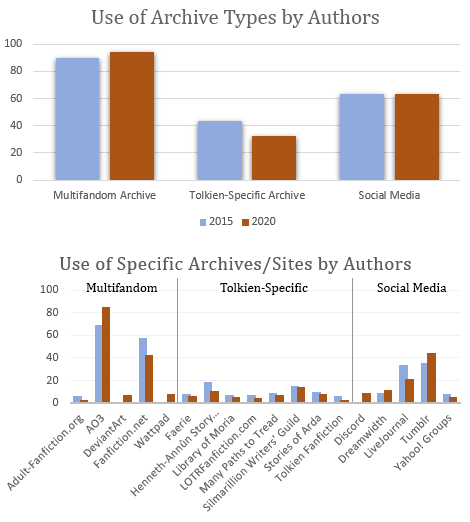
In 2020, that has begun to change. When considering the type of site where people post their stories—multifandom archives, Tolkien-specific archives, or social media sites—the greatest drop in participation is on the Tolkien-specific archives. This is, in a large part, due to the hemorrhaging of Tolkien-specific fanfiction archives in the last several years. The fandom history wiki Fanlore lists almost seventy Tolkien-specific archives; as of this writing, there are five still active that I am aware of, and most of them are minimally maintained. This represents, potentially, a tremendous loss in terms of fandom cultures, not just as sites for collecting fanworks about sometimes highly niche interests but also where fans with similar values and approaches to interpreting the canon and writing stories about it can gather and swap stories. It remains to be seen how this loss of culture will impact the broader fandom—or if it will. Will the fans who once participated on more niche archives leave the fandom? Will they adapt to the culture found on larger sites like AO3, or will they post there despite it? Will they use rising sites like Discord and Dreamwidth to recreate niche communities? Or will, eventually, we see the pendulum swing in the other direction and the return of more Tolkien-specific archives
Conclusion
The first known Tolkien fanfiction turned sixty years old last year. The vastness of the Tolkien fanfiction fandom threatens to be overwhelming, and while one small survey cannot capture all of it—not even close—I hope it has done its small part to do justice to the vastness, to the long-standing fan cultures nurtured by decades of fans, as well as the pillars, to those offbeat and sometimes zany fandom cultures that dot the fandom like cities across the map of Middle-earth: some ideal for grabbing a pint with friends, others known for their hushed and dusty libraries, but all unique and, in their small way, carrying Tolkien's legendarium forward.


Very interesting, Dawn, both…
Very interesting, Dawn, both the continuities and the changes!